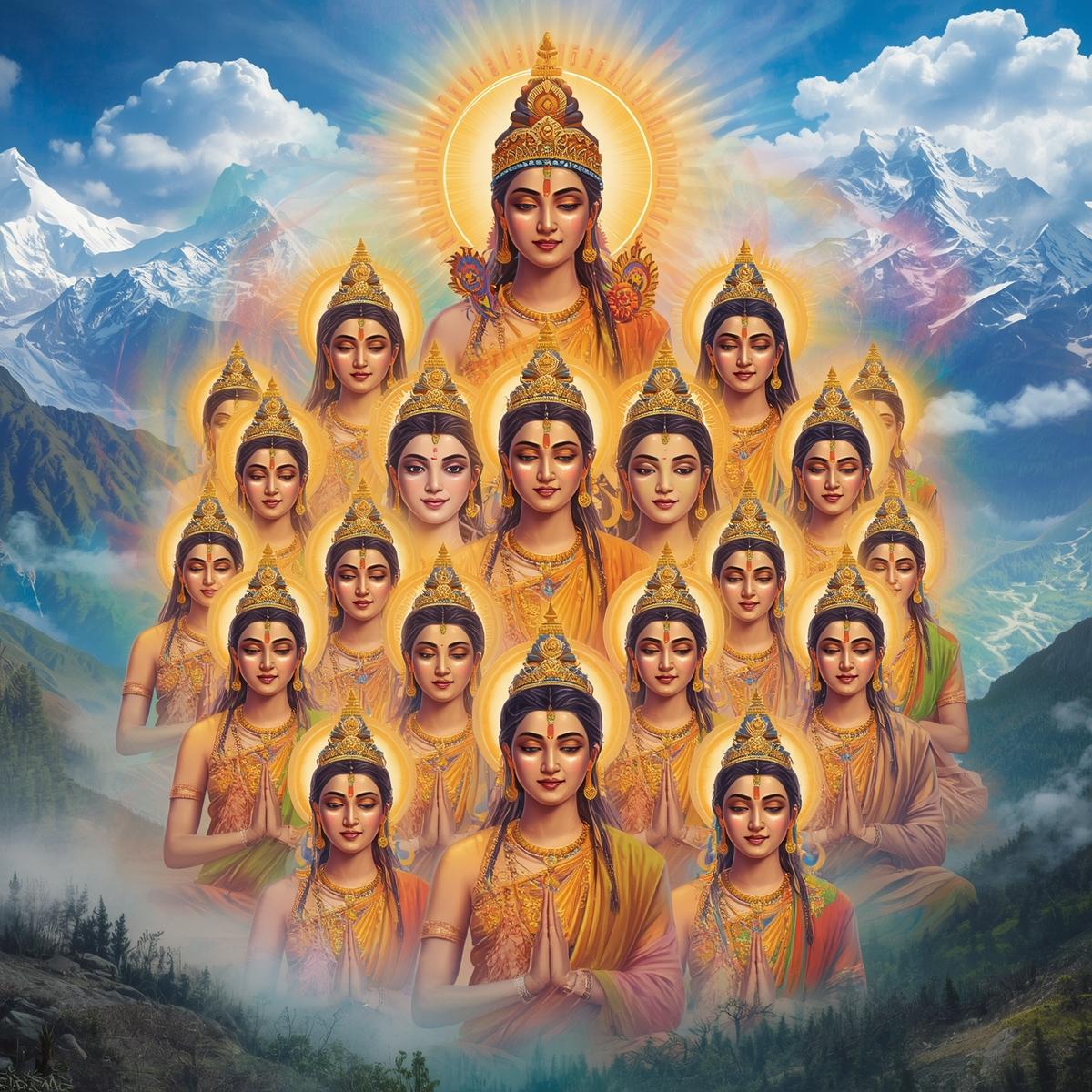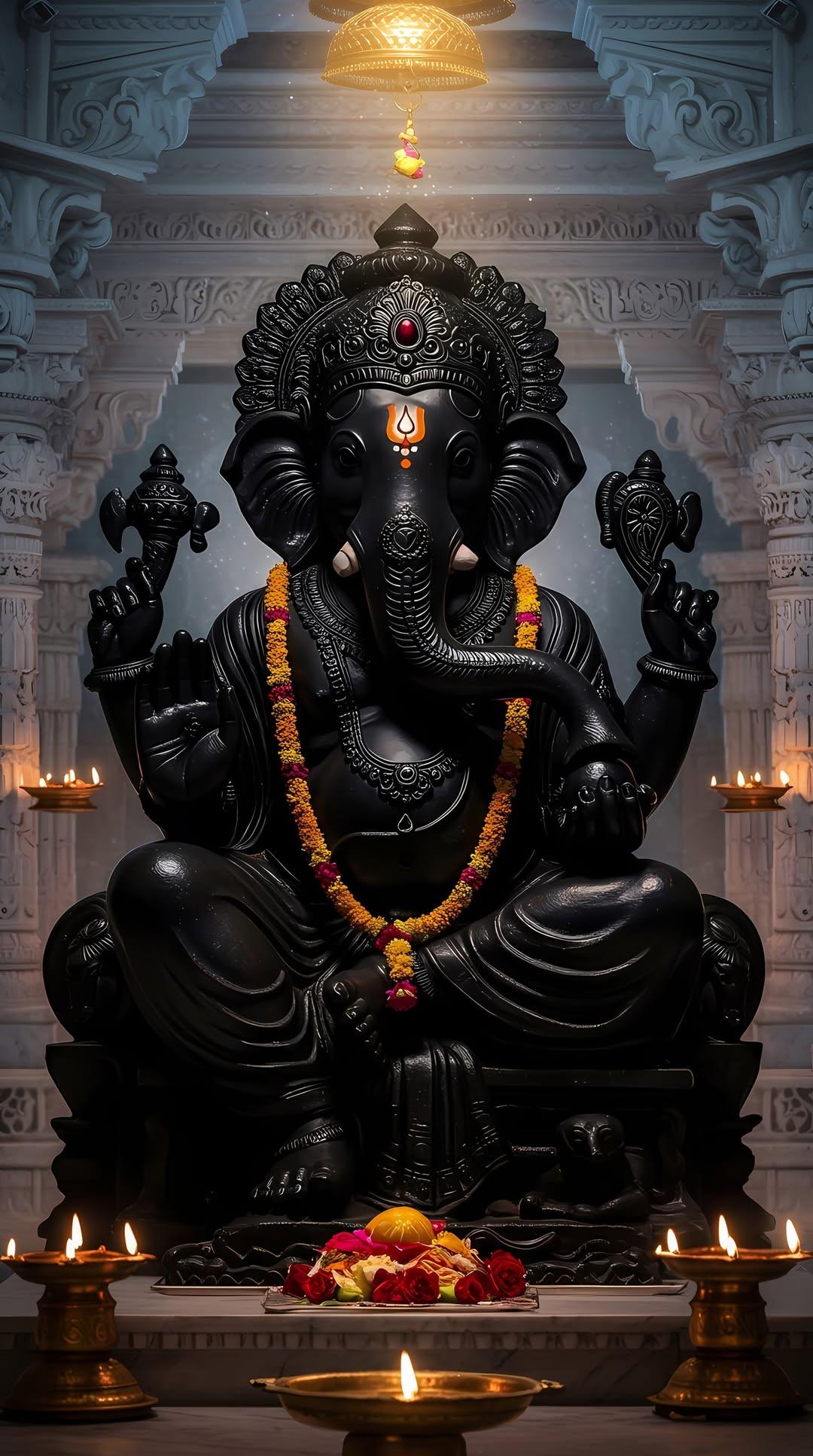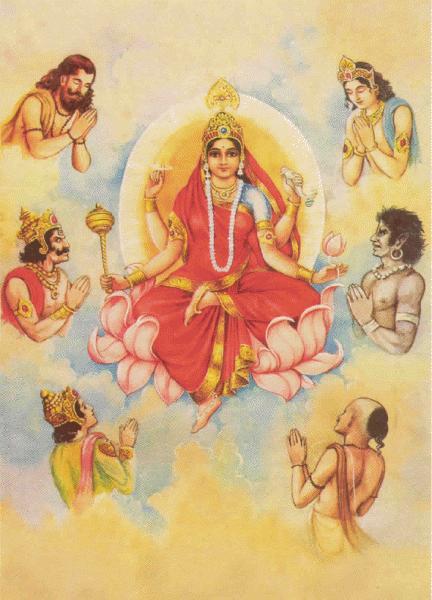"चौंसठ योगिनियाँ" — एक आध्यात्मिक दृष्टि से रहस्यमयी परिचय
"चौंसठ योगिनियों" के सम्बन्ध में साधारण जनमानस में अनेक अवधारणाएँ प्रचलित हैं, जो प्रायः सीमित एवं अपूर्ण हैं।
परंतु दिव्य हिमालय के सिद्धों के माध्यम से हमें इन दिव्य शक्तियों के गूढ़ आयामों की झलक प्राप्त होती है।
योगिनियाँ मात्र देवियाँ नहीं हैं, बल्कि वे आदिशक्ति के विविध रूपों की सजीव अभिव्यक्तियाँ हैं।
वे वह दिव्य ऊर्जा हैं जो सृष्टि, स्थिति और संहार — तीनों में व्याप्त होकर ब्रह्माण्डीय चक्र को संचालित करती हैं।
योगिनियाँ तीन प्रमुख गुणों — सत्त्व, रज और तम — में विभक्त मानी जाती हैं।
प्रत्येक गुण के अंतर्गत ६४-६४ योगिनियाँ आती हैं, अर्थात कुल संख्या १९२ होती है।
ये तीनों गुण मिलकर सृष्टि के सम्पूर्ण संतुलन का निर्माण करते हैं।
प्रत्येक योगिनी किसी न किसी तत्त्व, दिशा, ग्रह या चेतना के स्तर से सम्बद्ध होती है।
वे केवल बाह्य रूप से ही नहीं, बल्कि साधक के अंतःकरण में भी निवास करती हैं।
इन तीन विभागों — सत्त्व, रज और तम — से चयनित ६४ योगिनियाँ परम विशिष्ट कही जाती हैं।
यही वे योगिनियाँ हैं जिनकी उपासना "चौंसठ योगिनी तंत्र" में वर्णित है।
वे साक्षात् महामाया की चैतन्य शक्ति हैं — जो साधक को अज्ञान से ज्ञान, और सीमितता से अनन्तता की ओर ले जाती हैं।
कुछ साधकों में यह भ्रम पाया जाता है कि तमोगुण की योगिनियाँ ही "६४ कृत्याएँ" हैं,
परंतु वास्तव में "कृत्याएँ" योगिनियों का केवल एक आयाम हैं — जो शक्ति के कर्मरूप स्वरूप का प्रतिनिधित्व करती हैं।
हिमालय के दिव्य सिद्धों के अनुसार, इस कलियुग में योगिनी शक्ति प्रत्यक्ष रूप में संपूर्ण पृथ्वी पर विद्यमान है।
वे सृष्टि की धड़कन, चेतना की धार, और परमशक्ति की लीलामयी अभिव्यक्ति हैं।
जो साधक इनके रहस्य को समझ लेता है, वह जान जाता है कि
योगिनियों की उपासना किसी बाह्य देवी की नहीं, बल्कि अपने भीतर स्थित दिव्य शक्ति की साधना है।
यह साधना भय या मोह की नहीं, बल्कि आत्मबोध की यात्रा है —
जहाँ साधक अंततः स्वयं "योगिनी तत्त्व" में विलीन हो जाता है।
योगिनी शक्ति के सम्बन्ध में हम भविष्य में और भी विस्तार से चर्चा करेंगे।
फिलहाल के लिए इस विषय को यही विराम देते हैं।
नमो आदेश।
ॐ सम सिद्धाय नमः।
ॐ श्री पद्मप्रिया सुरम्या रमापति ईशपुत्राय नमः।
#Ishaputra #KaulantakPeeth #MahaHimalaya #Yogini #Sadhana #siddhi #yoga #MahasiddhaIshaputra #MahayogiSatyendranath #mystic #Meditation #Kulantpeeth
"चौंसठ योगिनियों" के सम्बन्ध में साधारण जनमानस में अनेक अवधारणाएँ प्रचलित हैं, जो प्रायः सीमित एवं अपूर्ण हैं।
परंतु दिव्य हिमालय के सिद्धों के माध्यम से हमें इन दिव्य शक्तियों के गूढ़ आयामों की झलक प्राप्त होती है।
योगिनियाँ मात्र देवियाँ नहीं हैं, बल्कि वे आदिशक्ति के विविध रूपों की सजीव अभिव्यक्तियाँ हैं।
वे वह दिव्य ऊर्जा हैं जो सृष्टि, स्थिति और संहार — तीनों में व्याप्त होकर ब्रह्माण्डीय चक्र को संचालित करती हैं।
योगिनियाँ तीन प्रमुख गुणों — सत्त्व, रज और तम — में विभक्त मानी जाती हैं।
प्रत्येक गुण के अंतर्गत ६४-६४ योगिनियाँ आती हैं, अर्थात कुल संख्या १९२ होती है।
ये तीनों गुण मिलकर सृष्टि के सम्पूर्ण संतुलन का निर्माण करते हैं।
प्रत्येक योगिनी किसी न किसी तत्त्व, दिशा, ग्रह या चेतना के स्तर से सम्बद्ध होती है।
वे केवल बाह्य रूप से ही नहीं, बल्कि साधक के अंतःकरण में भी निवास करती हैं।
इन तीन विभागों — सत्त्व, रज और तम — से चयनित ६४ योगिनियाँ परम विशिष्ट कही जाती हैं।
यही वे योगिनियाँ हैं जिनकी उपासना "चौंसठ योगिनी तंत्र" में वर्णित है।
वे साक्षात् महामाया की चैतन्य शक्ति हैं — जो साधक को अज्ञान से ज्ञान, और सीमितता से अनन्तता की ओर ले जाती हैं।
कुछ साधकों में यह भ्रम पाया जाता है कि तमोगुण की योगिनियाँ ही "६४ कृत्याएँ" हैं,
परंतु वास्तव में "कृत्याएँ" योगिनियों का केवल एक आयाम हैं — जो शक्ति के कर्मरूप स्वरूप का प्रतिनिधित्व करती हैं।
हिमालय के दिव्य सिद्धों के अनुसार, इस कलियुग में योगिनी शक्ति प्रत्यक्ष रूप में संपूर्ण पृथ्वी पर विद्यमान है।
वे सृष्टि की धड़कन, चेतना की धार, और परमशक्ति की लीलामयी अभिव्यक्ति हैं।
जो साधक इनके रहस्य को समझ लेता है, वह जान जाता है कि
योगिनियों की उपासना किसी बाह्य देवी की नहीं, बल्कि अपने भीतर स्थित दिव्य शक्ति की साधना है।
यह साधना भय या मोह की नहीं, बल्कि आत्मबोध की यात्रा है —
जहाँ साधक अंततः स्वयं "योगिनी तत्त्व" में विलीन हो जाता है।
योगिनी शक्ति के सम्बन्ध में हम भविष्य में और भी विस्तार से चर्चा करेंगे।
फिलहाल के लिए इस विषय को यही विराम देते हैं।
नमो आदेश।
ॐ सम सिद्धाय नमः।
ॐ श्री पद्मप्रिया सुरम्या रमापति ईशपुत्राय नमः।
#Ishaputra #KaulantakPeeth #MahaHimalaya #Yogini #Sadhana #siddhi #yoga #MahasiddhaIshaputra #MahayogiSatyendranath #mystic #Meditation #Kulantpeeth
"चौंसठ योगिनियाँ" — एक आध्यात्मिक दृष्टि से रहस्यमयी परिचय
"चौंसठ योगिनियों" के सम्बन्ध में साधारण जनमानस में अनेक अवधारणाएँ प्रचलित हैं, जो प्रायः सीमित एवं अपूर्ण हैं।
परंतु दिव्य हिमालय के सिद्धों के माध्यम से हमें इन दिव्य शक्तियों के गूढ़ आयामों की झलक प्राप्त होती है।
योगिनियाँ मात्र देवियाँ नहीं हैं, बल्कि वे आदिशक्ति के विविध रूपों की सजीव अभिव्यक्तियाँ हैं।
वे वह दिव्य ऊर्जा हैं जो सृष्टि, स्थिति और संहार — तीनों में व्याप्त होकर ब्रह्माण्डीय चक्र को संचालित करती हैं।
योगिनियाँ तीन प्रमुख गुणों — सत्त्व, रज और तम — में विभक्त मानी जाती हैं।
प्रत्येक गुण के अंतर्गत ६४-६४ योगिनियाँ आती हैं, अर्थात कुल संख्या १९२ होती है।
ये तीनों गुण मिलकर सृष्टि के सम्पूर्ण संतुलन का निर्माण करते हैं।
प्रत्येक योगिनी किसी न किसी तत्त्व, दिशा, ग्रह या चेतना के स्तर से सम्बद्ध होती है।
वे केवल बाह्य रूप से ही नहीं, बल्कि साधक के अंतःकरण में भी निवास करती हैं।
इन तीन विभागों — सत्त्व, रज और तम — से चयनित ६४ योगिनियाँ परम विशिष्ट कही जाती हैं।
यही वे योगिनियाँ हैं जिनकी उपासना "चौंसठ योगिनी तंत्र" में वर्णित है।
वे साक्षात् महामाया की चैतन्य शक्ति हैं — जो साधक को अज्ञान से ज्ञान, और सीमितता से अनन्तता की ओर ले जाती हैं।
कुछ साधकों में यह भ्रम पाया जाता है कि तमोगुण की योगिनियाँ ही "६४ कृत्याएँ" हैं,
परंतु वास्तव में "कृत्याएँ" योगिनियों का केवल एक आयाम हैं — जो शक्ति के कर्मरूप स्वरूप का प्रतिनिधित्व करती हैं।
हिमालय के दिव्य सिद्धों के अनुसार, इस कलियुग में योगिनी शक्ति प्रत्यक्ष रूप में संपूर्ण पृथ्वी पर विद्यमान है।
वे सृष्टि की धड़कन, चेतना की धार, और परमशक्ति की लीलामयी अभिव्यक्ति हैं।
जो साधक इनके रहस्य को समझ लेता है, वह जान जाता है कि
योगिनियों की उपासना किसी बाह्य देवी की नहीं, बल्कि अपने भीतर स्थित दिव्य शक्ति की साधना है।
यह साधना भय या मोह की नहीं, बल्कि आत्मबोध की यात्रा है —
जहाँ साधक अंततः स्वयं "योगिनी तत्त्व" में विलीन हो जाता है।
योगिनी शक्ति के सम्बन्ध में हम भविष्य में और भी विस्तार से चर्चा करेंगे।
फिलहाल के लिए इस विषय को यही विराम देते हैं।
नमो आदेश।
ॐ सम सिद्धाय नमः।
ॐ श्री पद्मप्रिया सुरम्या रमापति ईशपुत्राय नमः।
#Ishaputra #KaulantakPeeth #MahaHimalaya #Yogini #Sadhana #siddhi #yoga #MahasiddhaIshaputra #MahayogiSatyendranath #mystic #Meditation #Kulantpeeth









